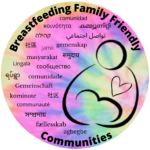The Breastfeeding Family Friendly Communities (BFFC) framework has long provided a roadmap for building supportive environments for breastfeeding families. In Western North Carolina, the SAFE Infant Feeding Team has leveraged this framework to address a unique challenge: supporting infant and young child feeding during emergencies. By applying the BFFC lens across 11 counties, the region is making strides in policy development, system changes, and community collaboration, proving that the 10 Steps are not only a foundation for everyday breastfeeding support but also a critical tool for disaster preparedness.
The BFFC Lens: Connecting Communities During Crisis
One of the most remarkable outcomes of this work is the way the BFFC framework has brought people together. It established a network that allowed partners to connect, share resources, and work collectively, even across county lines. While Buncombe County has long been recognized as a Breastfeeding Family Friendly Community, expanding the framework to the broader region has united stakeholders in Asheville and beyond.
By focusing on the 10 Steps, this regional collaboration ensures that breastfeeding remains central to infant feeding efforts during emergencies, when health risks are heightened, and resources are strained.
Reimagining the 10 Steps Through the Emergency Lens
Step 1: Leadership and Policy
Traditionally, Step 1 calls for policies from county commissioners to support breastfeeding. However, in emergency scenarios, we recognize the need for federal policies embedded in emergency response systems. Emergency responders must understand that breastfeeding is the safest option in a crisis and that indiscriminately providing formula can undermine breastfeeding efforts and increase risks. Advocacy for federal guidelines is essential to standardizing this knowledge across response teams.
Step 3: Health Leadership
Community health leaders play a critical role in promoting breastfeeding as the safest infant feeding option during emergencies. Ensuring that these leaders are informed and equipped to support breastfeeding parents is vital, as their influence shapes how resources and information flow during crises.
Step 4: Prenatal Education
Preparing families for emergencies starts long before a disaster strikes. During pregnancy, families need clear, evidence-based education about the importance of breastfeeding and its role in emergency preparedness. Prenatal programs must integrate this message to ensure families are informed and empowered.
Step 5: Breastfeeding-Friendly Healthcare
In emergencies, hospitals and healthcare systems need to be ready to support breastfeeding. Facilities that are already “Baby-Friendly” or hold breastfeeding-friendly designations are better equipped to provide consistent support during disasters. Investing in these designations before emergencies occur ensures continuity of care when it matters most.
Step 6: Breastfeeding Coalitions
Breastfeeding coalitions are the backbone of community support. In Western North Carolina, the pre-existing networks and problem-solving capacity of the region’s coalition have been invaluable. Addressing care gaps is far more difficult in the middle of an emergency, making coalitions a crucial element of preparedness.
Step 7 & Step 9: Support for Breastfeeding Parents at Work and in Public
Emergencies often disrupt normal work and public life, but breastfeeding support cannot pause. Workplaces need to adapt by allowing parents to bring nursing infants to work or avoid separation as much as possible. Public spaces must remain welcoming to breastfeeding families, ensuring that disruptions to daily life don’t undermine breastfeeding efforts.
Step 10: Education in Childcare Centers
Childcare providers must be equipped to handle human milk safely during emergencies, even without access to running water. Proper sanitation protocols and training ensure that childcare settings remain safe and supportive for breastfeeding families.
Lessons Learned: Building Resilience Before Disaster Strikes
Western North Carolina’s progress highlights a critical truth: preparing for emergencies starts with everyday efforts. A community that is already aligned with the BFFC framework is far better positioned to support families during crises.
The work of the SAFE Infant Feeding Team has demonstrated that steps like coalition building, prenatal education, and breastfeeding-friendly healthcare are not just nice-to-haves—they are life-saving measures when disaster strikes.
Next Steps: Scaling Up Emergency Readiness
As the region continues to expand its efforts, a few key priorities emerge:
- Advocating for Federal Policy: Embedding breastfeeding support into federal emergency response guidelines is essential for systemic change.
- Expanding Training: From emergency responders to childcare providers, training on breastfeeding support during emergencies must be widespread and consistent.
- Strengthening Coalitions: Regional coalitions need continued investment to maintain their role as problem solvers and connectors during crises.
- Raising Awareness: Communities must understand that breastfeeding is not only a personal choice but also a public health priority, especially in emergencies.
A Call to Action
Western North Carolina’s experience serves as a powerful reminder that the 10 Steps are more than a checklist—they are a framework for resilience. Whether in daily life or during an emergency, these steps guide communities in creating environments where breastfeeding families can thrive.
We encourage communities everywhere to embrace the BFFC framework as a foundation for both routine support and disaster preparedness. By working together, we can ensure that no matter the circumstances, families have the support they need to keep their infants safe and healthy.
